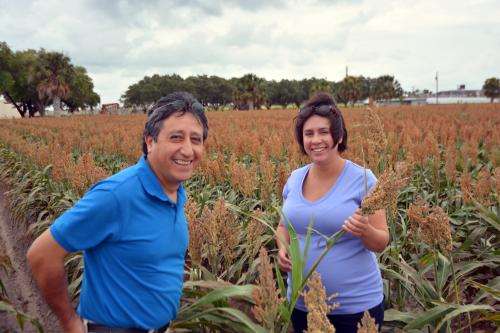Sugarcane aphids under control as South Texas grain sorghum harvest begins

After rising to alarming numbers, populations of the sugarcane aphid in South Texas grain sorghum have crashed, according to Texas A&M AgriLife Extension Service personnel.
"We expect to have a successful harvest beginning in early July, with little or no honeydew from the sugarcane aphids to clog up harvesting equipment," said Danielle Sekula-Ortiz, an AgriLife Extension integrated pest management agent in Weslaco.
Dr. Raul Villanueva, an AgriLife Extension entomologist at the Texas A&M AgriLife Research and Extension Center at Weslaco, said populations have risen again in the past week, but not to levels that should concern growers.
"We're not recommending that growers spray for the sugarcane aphid again this summer," he said. "Many growers are already putting down defoliants to help them harvest."
Sugarcane aphids feed on plant leaves, leaving a sticky waste called honeydew to clog up harvesting equipment, Villanueva said. Once in the grain head, they can keep the grain from maturing, reducing both quality and quantity.
Lower Rio Grande Valley growers have planted some 400,000 acres of grain sorghum, most of which is exported to Mexico as cattle feed.
Fortunately, about 80 percent of Rio Grande Valley sorghum growers adopted AgriLife Extension's spray program earlier in the season, "which worked quite well area-wide," Villanueva said
The 20 percent of growers who did not spray did not fare so well, he said.
"Most likely those who did not spray will not have a crop. Most fields were completely lost. Overall losses on untreated fields ran from 50 to 100 percent."
Sekula-Ortiz and Villanueva both said the overall population drop became readily evident once growers conducted their area-wide spraying.
"It's like when our citrus growers all spray at the same time for the Asian citrus psyllid," Sekula-Ortiz said. "It works. Overall population decreases are very obvious."
Fortunately, growers' application of Transform, an insecticide labeled by state and federal regulatory agencies on a temporary emergency basis, did not drastically reduce beneficial insects, which also helped keep sugarcane aphids at bay, Villanueva said.
"Large numbers of predators, natural enemies, were seen," he said. "They kept pace, which also helped kill off the sugarcane aphids. These would include lady beetles, syrphids, also known as hoverflies and sweat flies."
Environmental factors, including heat, may have also helped decrease populations, he added.
The sugarcane aphid in large numbers on grain sorghum is something new to the area, Villanueva said.
"We saw damaging populations of the sugarcane aphid in grain sorghum late in the fall season last year, and we observed some fields where all the yields were entirely lost," he said.
But then in mid-April and early May in this year's crop, Villanueva said, things took a turn for the worse, requiring quick action.
"We started seeing very high populations, about the time plants were putting out their grain heads. That's when we sent out the alert to growers."
Several hundred grain sorghum producers attended two field days at the Texas A&M center in Weslaco, one May 20 and another June 19, to learn about the sugarcane aphids' biology, how to identify them and how to treat their fields for them.
"We can't declare victory until the crop is harvested and safely in the grain bins," Villanueva said, "But so far, compared to what could have happened, we've fared very well."
Sekula-Ortiz said the area's fall grain sorghum crop may also see sugarcane aphid problems.
"We'll evaluate the situation then," she said. "At this point, we just don't know what will happen, but we'll likely have high populations again."
Because of its subtropical climate, Lower Rio Grande Valley growers typically plant a second, much smaller crop of about 50,000 acres in August, which they usually harvest in December.
"Like we saw last year, we may have a repeat of sugarcane aphid populations increasing and affecting sorghum yields in the fall." Villanueva said, "But this year we have an alternative to reduce the damaging effects of this pest. So, we're hoping late-season growers are prepared to stop sugarcane aphids before they reach damaging population levels."
Provided by Texas A&M University




















